Not only is sushi a fun meal to eat (as long as your chopstick skills are up to par), it’s also delicious and many people perceive it to be healthy. The “guilt-free” meal typically consists of miso soup or a seaweed salad to start off with. Then diners get a full plate of sushi with some pickled ginger, wasabi paste, and soy sauce on the side. If you are a sushi roll lover, you are munching on vinegar-flavored rice, fish, and vegetables rolled in seaweed paper known as nori. That all sounds pretty healthy, right? Well, keep reading to find out why your “healthy” sushi meal may be deceiving.
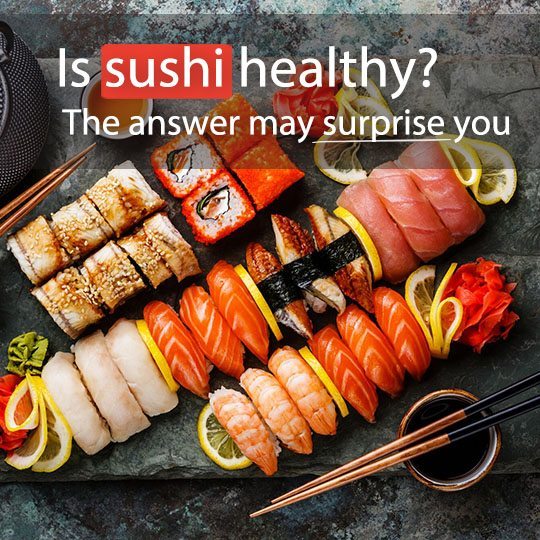
On the surface, it seems like sushi, a popular Japanese dish, is packed with all healthy ingredients. After all, ginger is one of the healthiest spices on the planet, miso is loaded with gut-friendly probiotics, fish is packed with protein and beneficial Omega 3 fatty acids, and rice offers fiber. That’s not to mention nori contains various vitamins and minerals such as vitamin A, vitamin C, vitamin E, calcium, magnesium, phosphorus, iron, sodium, iodine, and thiamine.
While there is no denying that sushi can be a healthy meal, there are some things that you need to know before ordering at your local sushi restaurant.
1) Seaweed Salad
Whenever you go to a restaurant, you probably assume if a dish has the word “salad” in it then it must be healthy. So naturally, a seaweed salad would seem like a healthy appetizer option. Not only is it “salad,” but if you’ve ever read the nutritional facts for seaweed then you know it’s also incredibly nutritious. It offers the body a geat deal of beneficial vitamins and minerals. With that said, the seaweed salad that’s served at most sushi places comes pre-made in bulk from distribution companies that load it up with unhealthy additives such as:
- High-fructose corn syrup
- Vegetable oil
- Artificial colors
- GMOs
These are all ingredients we’ve included in our list of dangerous food additives people should avoid! So, I’m sorry to break the news to you, but your seaweed salad probably isn’t as healthy as you thought it was.
What You Should Do:
If you are a lover of seaweed salad, it’s always a good idea to ask the restaurant if they make it in-house or if it comes pre-packaged. One giveaway that unnatural ingredients have been added to your seaweed salad is if it has an unusual bright green color.
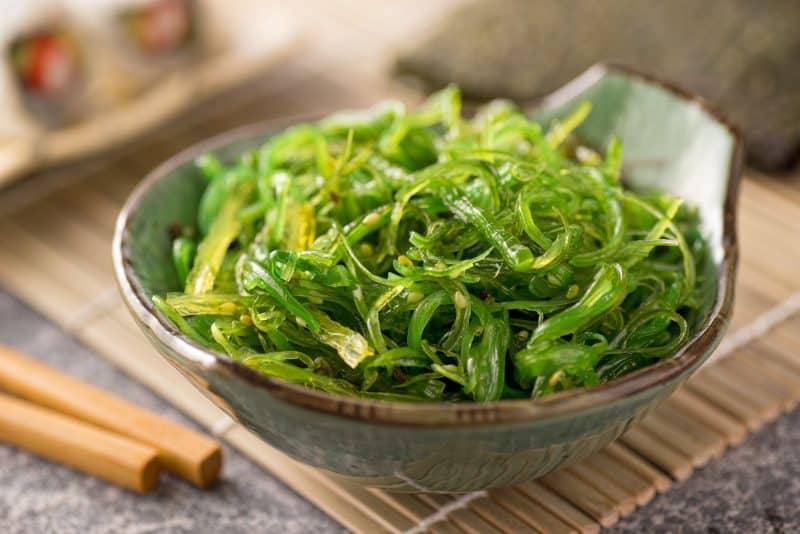
2) Sushi Rice
If you are someone who only eats sashimi at a sushi restaurant then you probably don’t eat a lot of rice. Sashimi is simply thin slices of raw fish. If you order rolls, though, then you are loading up on rice … and there are a few problems with the sushi rice.
First off – sushi restaurants typically use white rice in their rolls. White rice is refined and has been stripped of almost all it’s fiber, vitamins, and minerals. Don’t see anything wrong with that? Well, some research studies suggest eating a lot of refined carbs can promote inflammation. Since inflammation is at the root of almost all diseases, this isn’t something to take lightly.
That’s not the only problem, though. Sushi rice also contains hidden ingredients, such as sugar, to make it a bit sweeter. Sushi rice may also contain high-fructose corn syrup and the artificial sweetener Aspartame. Since these sugars and artificial sweeteners are broken down and digested quickly, they can cause spikes in blood sugar. Plus, there are a slew of other health risks associated with high sugar consumption.
Lastly, most sushi rice is high in salt. While there is nothing wrong with adding a dash of salt to your meals, it’s better when you are the one controlling the amount. Today, Americans are eating way too much salt and it’s not because they are flipping over the salt shaker. Rather, it’s because their food is arriving to them loaded with salt. In this case, most sushi rice is cooked in salt.
What You Should Do:
One thing you can do is ask your waiter/waitress to swap out the white rice for brown rice. Even better, you can request a rice-less roll. That means your rolls would simply consist of nori, fish, and vegetables. If you do have sushi that contains white rice, though, try to pick some of it off. That way you are eating less.
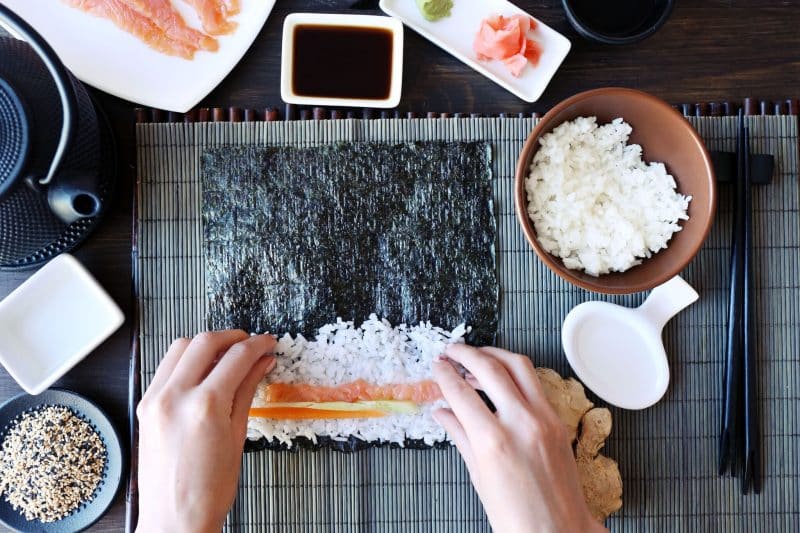
3) Ginger
Like I mentioned earlier, when your server brings you a plate of sushi, you will notice a pile of ginger on the side of your plate. A lot of people eat the ginger to cleanse their palate in between eating different pieces of sushi. Since ginger is one of the healthiest spices on the planet (it helps with digestive issues, eases nausea, and offers heart benefits), you may be surprised to find out that sushi ginger isn’t all that good for you. In fact, it’s not good for you at all. That’s because the ginger that’s served with sushi is pickled and unnatural. It’s been processed with dangerous food additives such as:
- Aspartame
- Monosodium glutamate (MSG)
- Artificial colors (if the ginger looks pink)
- Preservatives
What You Should Do:
Your best bet is to ditch the ginger altogether.

4) Wasabi
Have you ever wondered what that bright green pile of paste sitting on your sushi plate is? It’s called wasabi and many people eat it with their sushi. While this Japanese mustard offers many health benefits — such as fights inflammation, kills bad bacteria, and has anti-cancer properties — don’t expect to reap those health benefits from the wasabi at your local sushi restaurant. Only authentic wasabi offers such health benefits and authentic wasabi is extremely hard to come by. In fact, it’s estimated that only 5 percent of restaurants in Japan, and only very high-end restaurants in the United States, serve the real stuff that derives from the wasabia japonica root.
So what’s in the wasabi that you’re eating?
According to Dr. Andrew Weil, it’s a combination of horseradish, Chinese mustard, and green food coloring. It typically contains artificial coloring, artificial flavors, and GMOs. Again, these are all ingredients that we’ve included in our list of dangerous additives to avoid!
What You Should Do:
The first thing you can do is to ask your server if the wasabi is authentic. If not, there are some wasabi products on the market that are made from only horseradish, spirulina, and turmeric. This is a far better option than what you get at most sushi restaurants since there aren’t any dangerous additives. If you pick up your own wasabi, why not bring it with you to the sushi restaurant?
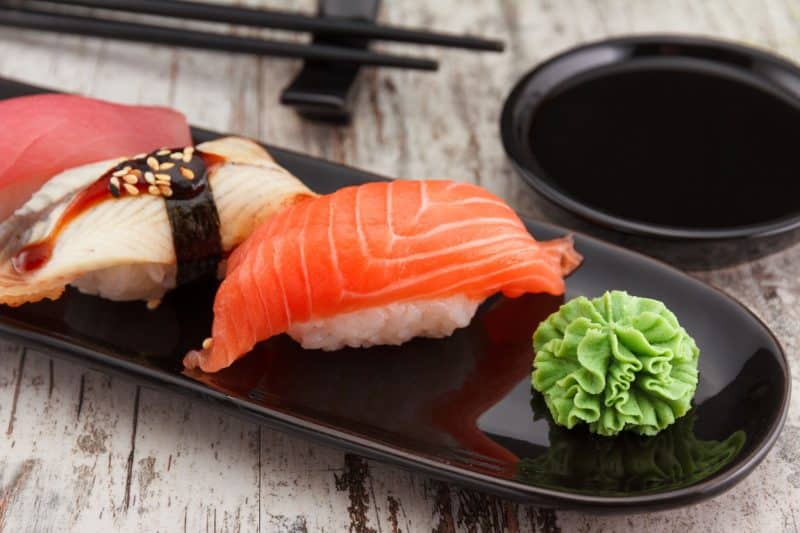
5) Soy Sauce
Do you like to dip your sushi in soy sauce? Some people love the added flavor and don’t enjoy sushi without it. However, soy sauce is loaded with salt and contains gluten. This can be a big problem for people who have celiac disease, are gluten intolerant, or simply like to avoid wheat in their diet.
What You Should Do:
If you suffer from celiac disease or have a wheat intolerance, use tamari rather than soy sauce. The taste is similar, but it doesn’t contain any gluten. In case your sushi restaurant doesn’t have any tamari, just bring a bottle with you.
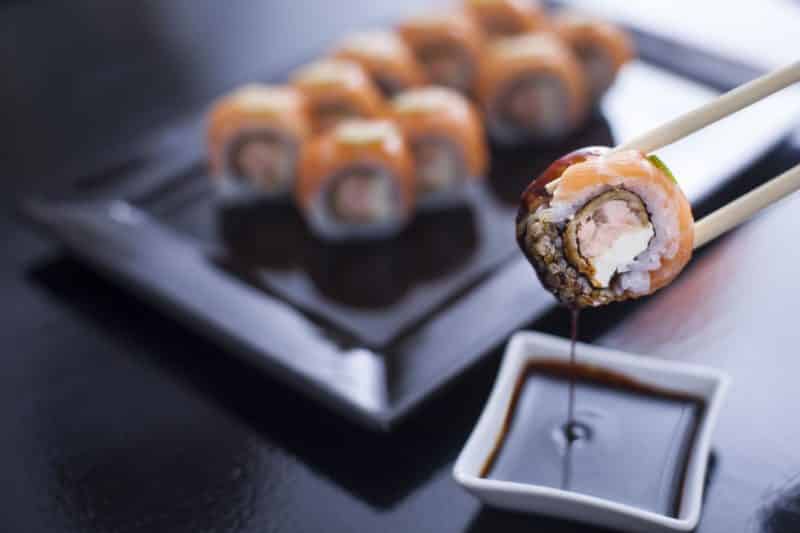
6) Other Sauces
Aside from soy sauce, there are a number of other popular condiments people use to dip and coat their sushi rolls to enhance the flavor. Most of these sauces are loaded with unhealthy fats, sugar, and sodium. For example:
- Spicy mayo is nothing but mayonnaise mixed with Sriracha or chili paste. This adds unnecessary unhealthy fats to your sushi meal.
- Eel/unagi sauce is a drool-worthy sauce that’s made from soy sauce (sodium) and sugar. It’s extremely thick and extremely unhealthy.
What You Should Do:
Avoid creamy sauces that add unhealthy fats to your meal.
7) Fish Roe
Some sushi restaurants coat their rolls with fish roe, which is just another name for seasoned caviar. While the fish roe adds a nice touch — both in presentation and flavor — the bright orange-colored fish eggs are actually commonly loaded with additives such as:
- High-fructose corn syrup
- Artificial coloring
- Monosodium glutamate (MSG)
Who knew something so little, that is used to coat a sushi roll, could be adding so many harmful ingredients to your meal?!
What You Should Do:
Ask for the fish roe to be left off your sushi.

8) Imitation Crab
When you go out for sushi, do you order the California roll? The California roll is often times the first thing people order since it’s cooked and is a good way to ease yourself into the raw stuff. If you order California rolls, though, it’s important to realize you aren’t eating real crab. Rather, California rolls are made with an imitation crab stick. That doesn’t mean what you’re eating doesn’t come from the sea, though.
Imitation crab, also called surimi, is made up of a variety of fish. It usually contains fish such as Alaskan pollock, mackerel, barracuda, blue whiting, and cod. You can think of imitation crab as the sea’s hotdog. Just like with a hotdog, a lot of ingredients are added to imitation crab. They include:
- Artificial flavors
- Monosodium glutamate (MSG)
- Starch
Since some manufacturers add starch to their imitation crab, that means it could contain gluten. So if you suffer from celiac disease or a wheat intolerance it’s best to avoid California rolls.

9) Tempura
Any roll that says it contains “tempura” means it’s been fried in vegetable oil. For example, shrimp tempura is fried shrimp. Some sushi restaurants even stuff little tempura bits into their sushi rolls. So if you bite down into a roll and experience a bready crunch, then the roll most likely contains tempura pieces. While tempura is absolutely delicious, it’s not healthy in the least bit. It’s nothing but unhealthy fat and is better to avoid.
What You Should Do:
On the menu, even if a roll doesn’t list that it contains tempura, it doesn’t hurt to ask your server. I’ve had rolls before where the chef snuck tempura in and it wasn’t listed on the menu. Better to be safe than sorry!
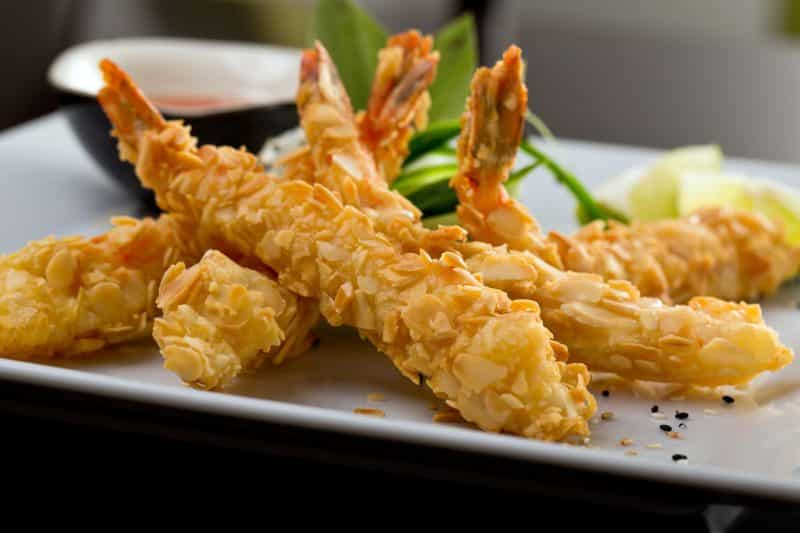
10) There Really Isn’t That Much Protein
When you go out for a sushi lunch or dinner, you probably feel good believing you’ve eaten a nice serving of protein and healthy fats. That’s because you know fish contains protein and Omega 3 fatty acids (especially fish such as salmon). Plus, a lot of sushi rolls contain avocado, which is a high-fat, protein-packed, healthy fruit.
Well, what if I was to tell you that you didn’t actually eat that much protein? In reality, there is very little fish and avocado in sushi rolls. Most of what you are eating is rice. So rather than being high protein, it’s actually high carb. Did you know researchers have found high carb diets don’t benefit weight loss like many people once thought?
What You Should Do:
Switch from sushi rolls to sashimi to assure you are eating a more hearty portion of protein.
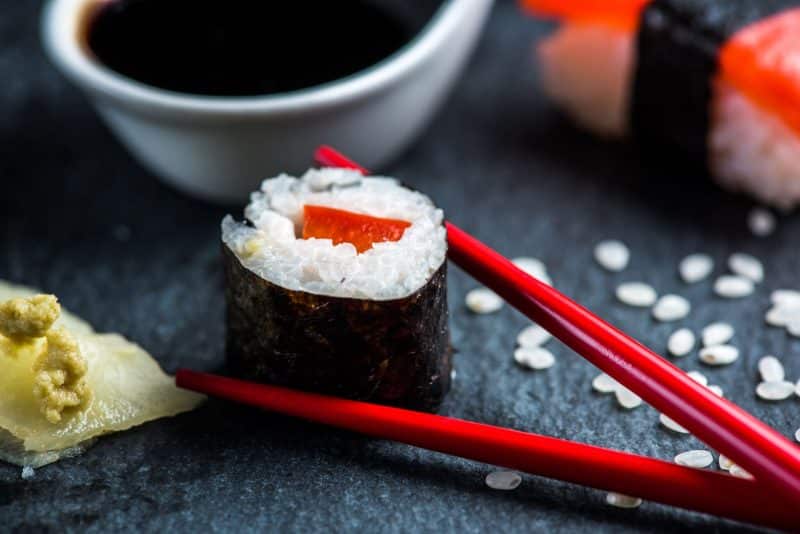
11) Mercury Levels
Due to heavy pollution in our oceans, most major waterways are contaminated with mercury, heavy metals, and various chemicals. These toxins directly affect our fish supply. One of the most talked about is mercury. Certain fish tend to have higher levels of mercury than others. This is especially the case with swordfish, mackerel, and tuna. In fact, one study conducted by the U.S. Geological Survey found that all tuna tested contained fairly high amounts of mercury. They found contamination may be worse in restaurants than in store-bought tuna.
What You Should Do:
When trying to avoid high levels of mercury, it’s best to reduce your intake/ avoid the types of fish that are most likely contaminated. Some fish that contain the lowest amount of mercury include salmon, eel, crab, and octopus.

12) Bacteria and Other Parasites
I know it’s hard for a sushi lover to hear, but the truth is, eating raw fish puts you at risk of infection. That’s because raw fish could contain dangerous bacteria and parasites. The often-talked about Salmonella is just one that you have to be careful of.
In one study, researchers examined raw fish used in 23 Portuguese restaurants. They found nearly 64 percent of the fish samples were contaminated with harmful microorganisms. The researchers said:
“The main result was that 63.93% of the analyzed samples were classified as unsatisfactory due to the high levels of mesophiles, Enterobacteriaceae, Staphylococcus aureus, Bacillus cereus, molds, and yeasts measured.”
Right now, the US Food and Drug Administration (FDA) doesn’t regulate the use of the “sushi grade fish” label. That means, there is no true guarantee that the fish you’re eating is safe.
What You Should Do:
Don’t eat raw sushi from any old hole in the wall sushi place. Go somewhere you know is reputable and has a high turnover rate so the fish is fresh.
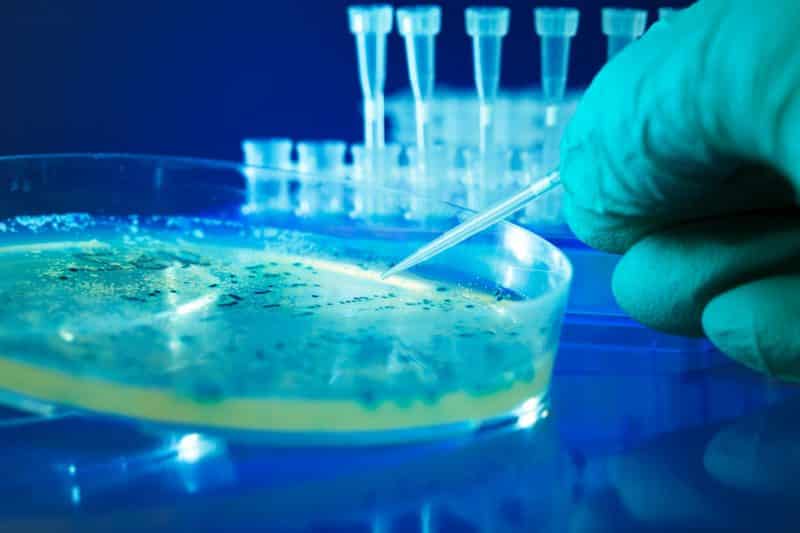
So Is Sushi Really Healthy?
Overall, the average sushi meal is loaded with carbs, sugar, salt, and unhealthy ingredient additives. It’s also low in fiber, protein, and healthy fats. With that said, a trip to your local sushi restaurant doesn’t have to be a nutritional nightmare.
Tips To Make Your Sushi Meal Healthier
- Go somewhere you know has a high turnover so the fish is fresh
- Stick to sashimi
- If you do eat sushi rolls, ask for rice-less rolls
- If you do have rice on your rolls then ask for brown rice instead of white rice (or pick a lot of the white rice off)
- Avoid anything with the word “tempura”
- Avoid creamy and thick sauces
- Bring your own sauces/sides
- Ask your server questions about seaweed salads and other questionable menu items
- Avoid loading up on tuna and other fish known to have high mercury levels


